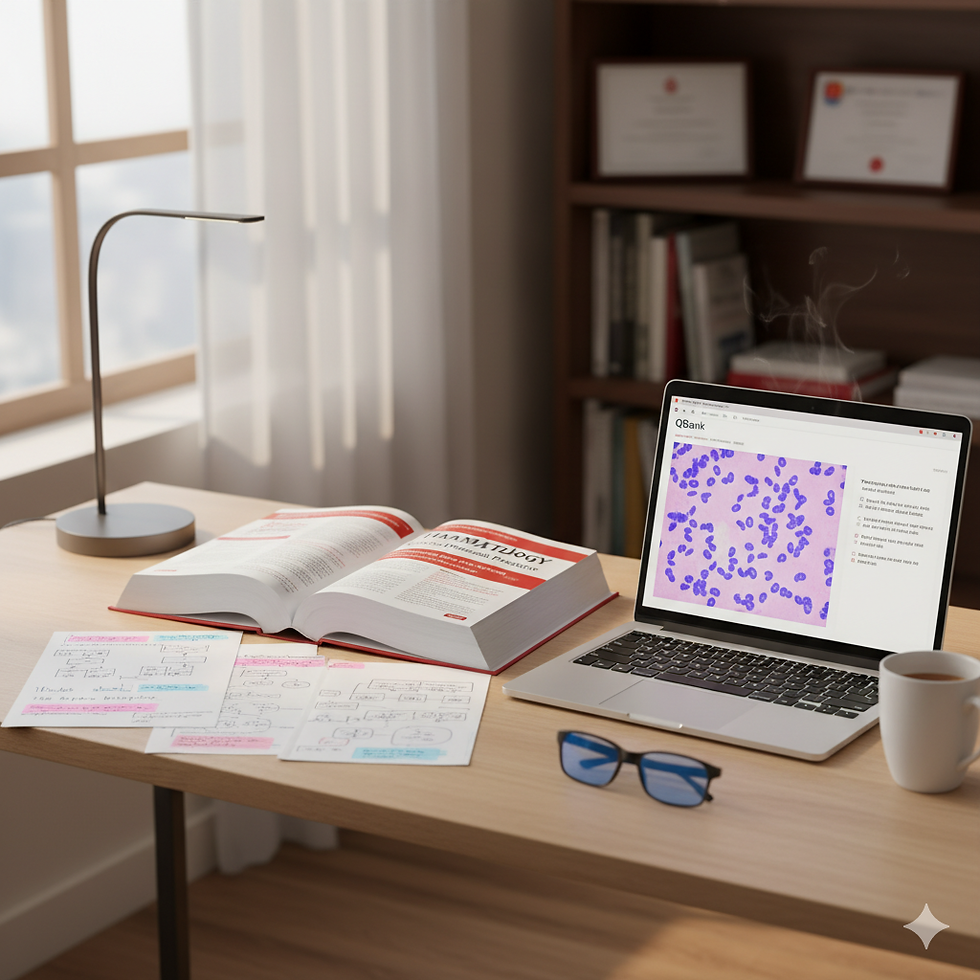MRCP Part 1 Rheumatology: 50 Rapid-Review Facts
- Crack Medicine

- 1 day ago
- 3 min read
TL;DR
This clinician-written guide, MRCP Part 1 Rheumatology: 50 Rapid-Review Facts, condenses the most examinable concepts in Rheumatology — from antibodies and vasculitis to drug pearls and tricky differentials. Use this to solidify core knowledge, practise pattern recognition, and revise efficiently for your MRCP Part 1 exam.
Why this matters
Rheumatology makes up roughly 5–10% of MRCP Part 1 questions, often blending immunology, pharmacology, and internal medicine. The questions are concept-heavy but highly predictable. Candidates who master antibody patterns, drug monitoring, and vasculitis subtypes often score above average.
This article summarises the 50 must-know facts that come up again and again, distilled by the teaching team at Crack Medicine, with linked access to our MRCP Part 1 overview and Free MRCP MCQs.
50 Rapid-Review Facts in Rheumatology
1. Autoimmune & Antibody Essentials
ANA – sensitive for SLE, but not specific.
Anti-dsDNA – correlates with lupus activity, especially nephritis.
Anti-Sm – most specific for SLE.
Anti-Jo-1 – linked to polymyositis/dermatomyositis.
Anti-Ro (SSA) – neonatal lupus and congenital heart block.
Anti-RNP – overlap (mixed connective tissue disease).
Rheumatoid factor – IgM against Fc of IgG.
Anti-CCP – highly specific for rheumatoid arthritis (RA).
c-ANCA (PR3) – granulomatosis with polyangiitis (GPA).
p-ANCA (MPO) – microscopic polyangiitis.
2. Connective Tissue Disease Highlights
SLE: Malar rash spares nasolabial folds; renal disease predicts prognosis.
Systemic sclerosis: Diffuse → early visceral disease; limited → CREST.
Dermatomyositis: Heliotrope rash + Gottron’s papules; check for malignancy.
Sjögren’s syndrome: Dry eyes/mouth; ↑ lymphoma risk.
Mixed connective tissue disease: Anti-RNP positive overlap pattern.
3. Vasculitis Essentials
Giant cell arteritis: Jaw claudication, visual loss risk—start steroids before biopsy.
Takayasu arteritis: “Pulseless disease” in young women; aortic involvement.
Polyarteritis nodosa: HBV association; spares lungs.
Microscopic polyangiitis: p-ANCA positive; renal + pulmonary.
Granulomatosis with polyangiitis: Upper airway, lung, kidney triad.
4. Crystal Arthropathies
Gout: Needle-shaped, negatively birefringent crystals (yellow parallel).
Pseudogout: Rhomboid, positively birefringent (blue parallel).
Triggers: Thiazides, CKD, alcohol binges.
Acute gout treatment: NSAID or colchicine; avoid allopurinol initially.
Allopurinol: Start after 2–3 weeks of colchicine prophylaxis.
5. Inflammatory Arthropathies
RA: MCP/PIP joints, prolonged morning stiffness.
RA extra-articular: Nodules, vasculitis, ILD, pericarditis.
Psoriatic arthritis: DIP + nail pitting; “pencil-in-cup” deformity.
Reactive arthritis: “Can’t see, can’t pee, can’t climb a tree.”
Ankylosing spondylitis: Young male, HLA-B27, sacroiliitis.
6. Drug & Treatment Pearls
Methotrexate: Monitor LFTs/FBC; teratogenic; folic acid rescue.
Hydroxychloroquine: Annual retinal exam.
Leflunomide: Long half-life; cholestyramine washout if toxicity.
TNF inhibitors: Screen for latent TB & HBV.
Steroids: Add bisphosphonate if >3 months use.
7. Mimics & Confounders
Fibromyalgia: Widespread pain, normal CRP.
Polymyalgia rheumatica: Age >50, proximal stiffness, raised ESR.
Osteoarthritis: Non-inflammatory, affects DIP + 1st CMC joints.
Haemochromatosis: MCP2/3 arthropathy, ↑ ferritin.
Viral arthritis: Parvovirus B19, self-limiting.
8. Systemic Complications
Lupus nephritis: Class IV → diffuse proliferative, biopsy before therapy.
Scleroderma renal crisis: ACE inhibitors life-saving.
Vasculitic neuropathy: Mononeuritis multiplex.
RA-associated ILD: Caplan’s syndrome (RA + pneumoconiosis).
Amyloidosis: Secondary (AA) after chronic inflammation.
9. Diagnostic Clues
ANA by immunofluorescence = gold standard.
Anti-centromere: Limited sclerosis; anti-Scl-70: diffuse type.
Arthrocentesis: Diagnostic in crystal or septic arthritis.
Musculoskeletal ultrasound: Detects synovitis early.
Always correlate serology with clinical context.
Mini-Case Example
Case: A 30-year-old woman with photosensitive rash, arthralgia, and proteinuria. ANA positive, anti-dsDNA high, low C3/C4.
Question: What is the next step? Answer: Renal biopsy. Rationale: MRCP Part 1 questions favour diagnostic reasoning over memorisation. Here, lupus nephritis classification (ISN/RPS) determines therapy, so biopsy is critical before immunosuppression.

Common Pitfalls (and How to Avoid Them)
Memorising isolated antibodies instead of disease clusters.
Ignoring drug safety (methotrexate, hydroxychloroquine).
Forgetting systemic screening in connective tissue disease stems.
Confusing gout vs. pseudogout birefringence (remember: Needle-Yellow-Negative).
Overlooking vasculitic overlap syndromes.
Study-Tip Checklist
Week | Focus Area | Tool / Strategy |
1–2 | Antibody patterns | Flashcards + Free MRCP MCQs |
3–4 | Vasculitis & arthritis | Case-based revision |
5–6 | Drug safety & monitoring | Summary tables |
7–8 | Systemic complications | Clinical vignette drills |
9–10 | Full mocks + error logs | Start a mock test |
FAQs
1. How many Rheumatology questions are in MRCP Part 1?
Around 15–20, often integrated with Immunology and Pharmacology.
2. What’s the hardest Rheumatology topic for most candidates?
Vasculitis classification and systemic sclerosis.
3. How can I memorise antibodies effectively?
Use pattern grouping — e.g., ANA-based, myositis-specific, vasculitis-related.
4. Which drug monitoring guidelines should I know?
Follow NICE DMARD safety guidance.
5. What’s the best way to practise Rheumatology questions?
Timed sessions in a realistic interface — try Crack Medicine’s QBank or MRCP(UK) sample questions.
Ready to start?
Rheumatology can be a high-scoring subject in MRCP Part 1 when revised systematically. Revisit these 50 rapid-review facts weekly and integrate them into practice sessions. Reinforce learning with Free MRCP MCQs, full-length mock tests, and concise video lectures to boost accuracy and recall.
Sources
British Society for Rheumatology Clinical Guidelines
NICE Clinical Knowledge Summaries – Rheumatology



Comments